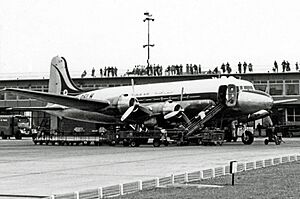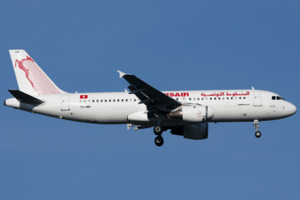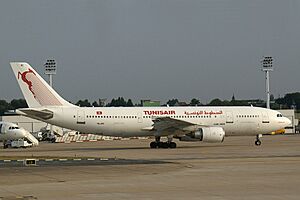Tunisair facts for kids

Tunisair Airbus A320
|
|
| Founded | 1948 |
|---|---|
| Commenced operations | 1 April 1949 |
| Hubs | Tunis–Carthage International Airport |
| Frequent-flyer program | Fidelys |
| Fleet size | 30 |
| Destinations | 44 |
| Headquarters | Tunis, Tunisia |
| Key people | Halima Ibrahim Khouaja (CEO) |
Tunisair (الخطوط التونسية) is the main airline of Tunisia. It was started in 1948. Tunisair flies to many countries across four continents. Its main airport is Tunis–Carthage International Airport. The airline's main office is in Tunis, close to the airport.
Contents
History of Tunisair
Tunisair was created by the government of Tunisia in late 1948. It was first called Société Tunisienne de l'Air. The airline began flying on April 1, 1949. Air France helped Tunisair start by giving it some planes and flight routes. These first routes included flights from Tunis to places like Algiers, Nice, Rome, and Marseille.
In the early 1950s, Tunisair added more cities to its flight map. By 1951, it flew to Casablanca, Ghudamis, and Tripoli. In 1953, the flight to Marseille was extended to Paris. In 1954, Tunisair started using a larger plane, a Douglas DC-4, for its Paris flights. By 1955, the airline carried over 92,000 passengers. In 1957, the Tunisian government became the main owner of the airline.
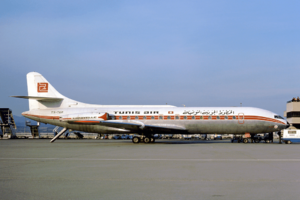
Tunisair received its first jet plane, a Sud Caravelle III, in August 1961. This was a big step forward! They started a new flight to Frankfurt in Germany. A second Caravelle jet joined the fleet in 1964. By 1969, Tunisair also started using the Nord 262 plane. These new jets helped the airline stop using its older propeller planes.

In 1972, Tunisair got its first Boeing plane, a Boeing 727-200. This plane was used for the busy Tunis–Paris route. On April 1, 1972, Tunisair also started flights to London and Jeddah. Over the next few years, more Boeing 727s were added. These planes helped Tunisair replace its Caravelle jets and older DC-3 planes.
In 1995, Tunisair's shares were sold on the Tunis stock exchange for the first time. This meant that people could buy parts of the company. By April 2000, the airline had over 7,000 employees. Its fleet included different types of Airbus and Boeing planes. Tunisair flew to many cities across Europe, Africa, and the Middle East.
In 2011, Tunisair started flying to Moscow. In July 2016, the airline launched its first flight across the Atlantic Ocean, from Tunis to Montreal in Canada.
How Tunisair Works
Ownership and Leadership
As of October 2024, the Tunisian government owns most of Tunisair (about 65%). Other parts are owned by national funds and a small part by Air France. The company is led by a head of general management and a chairman of the board.
Business Information
Tunisair carries millions of passengers each year. For example, in 2018, it carried about 3.8 million passengers. The airline works hard to connect Tunisia with many places around the world.
Main Office
Tunisair's main office is located near Tunis–Carthage International Airport in Tunis.
Where Tunisair Flies
Tunisair flies to many places in Africa, Asia, Europe, and North America. Its main hub is Tunis–Carthage International Airport. As of November 2023, Tunisair serves 24 countries with 68 different flight routes.
Partner Airlines
Tunisair works with other airlines to offer more flight options. This is called a Codeshare agreement. Some of its partners include:
Tunisair also has agreements with other airlines like Air Canada and Kuwait Airways to make travel easier for passengers.
Tunisair's Planes
Current Fleet
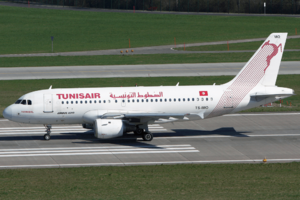
As of May 2025, the Tunisair fleet has the following planes:
| Aircraft | In Service | Orders | Passengers | Notes | ||
|---|---|---|---|---|---|---|
| C | Y | Total | ||||
| Airbus A319-100 | 2 | — | 12 | 102 | 114 | |
| Airbus A320-200 | 11 | — | 32 | 114 | 146 | |
| — | 162 | 162 | ||||
| Airbus A320neo | 5 | — | 12 | 138 | 150 | |
| Airbus A330-200 | 2 | — | 24 | 242 | 266 | |
| Total | 20 | 0 | ||||
Past Planes
Over the years, Tunisair has also used other types of planes, such as:
New Planes Joining the Fleet
Tunisair was the first airline in the Arab World and Africa to order the Airbus A319 in 1997. They also ordered Airbus A320s and Boeing 737-600s. These new planes helped replace older models like the Boeing 727s. The airline received its first A319 in August 1998.
In 2008, Tunisair ordered new Airbus A330-200s and more Airbus A320s. They received their first Airbus A330-200 in June 2015. Later, they also added new Airbus A320neo planes to their fleet.
Safety Record
Tunisair has a good safety record. Since it started in 1948, no one has died in an accident on a Tunisair flight. However, there have been a few incidents where planes were badly damaged:
- On January 12, 1979, a Boeing 727 was hijacked. The hijackers gave up in Libya, and everyone was safe.
- On February 11, 1992, a Boeing 727 rolled out of its hangar during a test because the brakes were not set. The plane was too damaged to be fixed.
- On February 6, 2013, an Airbus A320 went off the runway while landing at Tunis–Carthage International Airport. All 83 people on board survived, but the plane was too damaged to fly again.
See also
 In Spanish: Tunisair para niños
In Spanish: Tunisair para niños
- TunisAir Express
- Transport in Tunisia


